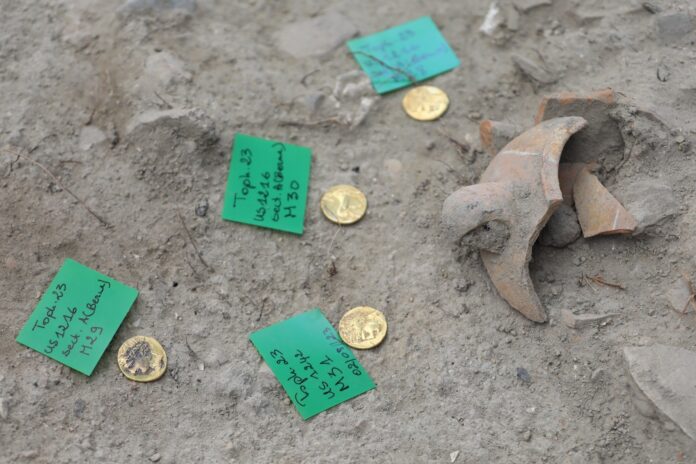Archaeologists have uncovered five 2,300-year-old gold coins, as well as the remains of young children, at the site of an ancient burial ground.
Researchers made the discovery during excavation works in the North African nation of Tunisia, in an area that once formed part of the territory of ancient Carthage, the country’s Ministry of Cultural Affairs has announced in a statement.
Carthage was a great city of antiquity founded by the Phoenicians on the north coast of Tunisia in the first millennium B.C. The city became a thriving port and trading center, eventually developing into a significant power in the Mediterranean. Carthage became a major rival to Rome, which eventually conquered and destroyed the city in 146 B.C.
Tunisian Ministry of Cultural Affairs
The archaeological site of ancient Carthage—added to UNESCO’s World Heritage List in 1979—lies in what is now a residential suburb of modern Tunisia’s capital Tunis.
Carthage had a sacred site known as a “tophet,” which served as a burial ground, particularly for young children.
Thousands of urns containing the ashes of young children have previously been found at the site, which was originally dedicated to the deities Baal Hammon and Tanit.
It is here that archaeologists found the five gold coins dating back to the 3rd century B.C. in August, as well as several urns with the remains of animals, infants and premature babies.
The gold coins reflect “the richness of that historical period and [affirm] the value of the civilization of Carthage,” the ministry said in a statement.
The rare gold coins measure around an inch across and have designs showing the face of Tanit—a symbol of motherhood, fertility and growth for the Carthaginians.
Archaeologists believe that the coins were left as offerings to Baal Hammon and Tanit by wealthy worshippers.
أعلن فريق الأبحاث الذي يشرف عليه المعهد الوطني للتراث اليوم 11 أوت 2023 عن اكتشاف علمي وتاريخي مهم تمثل في العثور على خمس قطع نقدية ذهبية تعود للقرن…
Tophets have been found at other Carthaginian sites, which were traditionally thought to house the victims of child sacrifice. Ancient Roman, Hellenistic and biblical sources attest to this, and some modern scholars agree.
However, the topic is controversial, with other experts arguing that tophets were simply children’s cemeteries for individuals who died naturally, or that not all the burials were sacrifices.
The latest finds are not the only recent discovery of ancient coins. Earlier in August, a metal detectorist found two gold coins from different historical eras on the same day in a field in England.
In July, archaeologists uncovered several 500-year-old gold coins during excavations at the ruins of a medieval monastery in Germany.
Also in July, the Israel Antiquities Authority announced that a rare silver coin dated to the time of the First Jewish Revolt against the Roman Empire, between A.D. 66 and 70, had been discovered in the Judean Desert.


